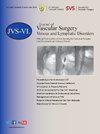快速运动后静脉补充时间是慢性静脉功能不全的独立因素。
IF 2.8
2区 医学
Q2 PERIPHERAL VASCULAR DISEASE
Journal of vascular surgery. Venous and lymphatic disorders
Pub Date : 2025-07-23
DOI:10.1016/j.jvsv.2025.102292
引用次数: 0
摘要
背景:慢性静脉功能不全(CVI)可导致疼痛、肿胀、水肿、皮肤变化和下肢溃疡等并发症。瓣膜功能不全和静脉阻塞是公认的CVI的诱因。运动后静脉充盈时间(P-EVRT),即静脉体积描记研究中小腿肌肉收缩后静脉充盈的时间,是CVI的一个未被充分研究的因素。方法和结果:在这项横断面研究中,4,755例患者进行了静脉空气体积描记术评估,9,510例下肢根据运动后静脉再填充时间(P-EVRT)分为两组:快速组(< 20秒;N = 5256)和normal (N = 4254)。快速P-EVRT与较高的平均CEAP评分相关(3.2 vs 2.5)。结论:在这项使用静脉空气体积描记术的大型当代研究中,我们证明运动后快速静脉再填充是一个重要且独特的静脉生理参数,可以帮助我们了解CVI的临床严重程度。本文章由计算机程序翻译,如有差异,请以英文原文为准。
Rapid post exercise venous refilling time is an independent contributor to chronic venous insufficiency
Background
Chronic venous insufficiency (CVI) results in complications such as pain, swelling, edema, skin changes, and ulcerations of the lower extremities. Valvular incompetence and venous obstruction are well-recognized contributors to CVI. Post-exercise venous refilling time (P-EVRT), the time to refill veins after calf muscle contractions during venous plethysmography study, is an understudied contributor to CVI.
Methods
In this cross-sectional study of 4755 patients who were evaluated with venous air plethysmography, 9510 lower limbs were categorized based on P-EVRT into two groups: rapid (<20 seconds; n = 5256) and normal (n = 4254).
Results
Rapid P-EVRT was associated with higher mean CEAP scores (3.2 vs 2.5; P < .001) and a higher prevalence of active/prior ulcers (11.6 vs 4.1%; P < .001). Univariable analysis showed that age, male sex, the severity of incompetence, obstruction, calf pump function, and rapid P-EVRT were all significantly associated with active/prior ulcers. After multivariable adjustment for these significant factors, rapid P-EVRT was an independent contributor to active/prior ulcers (odds ratio, 1.44; 95% confidence interval, 1.17-1.77). Among limbs without other venous pathology by plethysmography (incompetence, obstruction, reduced calf pump function), rapid P-EVRT remained significantly associated with higher mean CEAP scores (P < .001) and a higher prevalence of venous ulcers than limbs with normal P-EVRT (5.7% vs 2.7%; P = .001).
Conclusions
In this large contemporary study using venous air plethysmography, we demonstrate that rapid P-EVRT is an important and unique venous physiologic parameter that informs our understanding of the clinical severity of CVI.
求助全文
通过发布文献求助,成功后即可免费获取论文全文。
去求助
来源期刊

Journal of vascular surgery. Venous and lymphatic disorders
SURGERYPERIPHERAL VASCULAR DISEASE&n-PERIPHERAL VASCULAR DISEASE
CiteScore
6.30
自引率
18.80%
发文量
328
审稿时长
71 days
期刊介绍:
Journal of Vascular Surgery: Venous and Lymphatic Disorders is one of a series of specialist journals launched by the Journal of Vascular Surgery. It aims to be the premier international Journal of medical, endovascular and surgical management of venous and lymphatic disorders. It publishes high quality clinical, research, case reports, techniques, and practice manuscripts related to all aspects of venous and lymphatic disorders, including malformations and wound care, with an emphasis on the practicing clinician. The journal seeks to provide novel and timely information to vascular surgeons, interventionalists, phlebologists, wound care specialists, and allied health professionals who treat patients presenting with vascular and lymphatic disorders. As the official publication of The Society for Vascular Surgery and the American Venous Forum, the Journal will publish, after peer review, selected papers presented at the annual meeting of these organizations and affiliated vascular societies, as well as original articles from members and non-members.
 求助内容:
求助内容: 应助结果提醒方式:
应助结果提醒方式:


